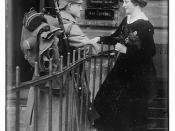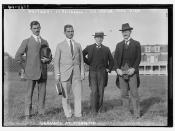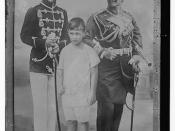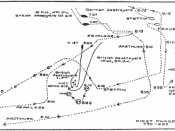Throughout the war the British fleets were superior. This was probably due to its large empire.
1914 The first naval battle was on August 28 when the British raided Heligoland Bight. British destroyers entered this German naval base and fired torpedoes but the Germans sent out cruiser ships, which were bigger and stronger. The destroyers retreated to open sea whilst being chased by the Germans and shot at by Battle ships.
In September, submarine warfare began when German submarine U-9, sank 3 British cruisers. Meanwhile, 3 British cruisers pursued 3 rival cruisers to the coast of Chile where on November 1st, the Battle of Coronel took place. The Germans sunk 2 British cruisers without loosing 1 ship. When they heard of this the British Admiralty sent 2 more battle cruisers to sink the Germans, but they had gone to the Falkland Islands to raid a British wireless and coaling station.
To their surprise they found a British squadron refuelling. The surprised, fleeing Germans were destroyed and 1,800 Germans died.
In the Indian Ocean, the German ship Emden attacking small ports and sea-side villages (allies to the British) but later in the beginning of November was destroyed by an Australian cruiser.
1915 On January 23rd, a German squadron went to raid the English coast, but the English had been warned, and sent a fleet to meet them. They met at Dogger Bank and the Germans fled. The British were faster and sunk one cruiser and their 2 flagships were damaged. Because of a misunderstanding of signals, the British attack was not as full on as it should have been so the remaining German ships escaped.
The reason the Americans got involved, was when the cruise liner Lusitania was torpedoed twice and sunk. 1,198 people died, 124 of them Americans. On August 19th, the British liner Arabic was lost and 4 more Americans died.
1916 The Battle of Jutland This was the only naval full-scale battle in World War 1. Neither side was prepared to loose this battle. On the 31st of May, the British Grand Fleet saw the full High Seas Fleet - 98 German ships sailing together. Both the British fleets advanced. David Beattys fleet took a parallel rout to the German ships and reached them first followed by Hugh Evan-Thomas's squadron. They opened fire and Beatty lost the ships Indefatigable and Queen Mary and received several hits to his flagship Lion. Beatty retreated to Sir John Jellicoe's main fleet. Both sides sustained many losses and took many casualties. That night when the main battle was over, the Germans tried to escape. They ran into the tail of a line of cruisers following Jellicoes southbound fleet. Once they were through the chaotic firing, sinkings and collisions of the night they went back to the Jade Anchorage.
1917 By 1917, Germany had built up its navy and because of this and unrestricted submarine warfare Britain almost had to pull out of the war at sea with their depleted navy. But they did not have to because Britain would of needed supplies, so some of the remaining ships of the British fleet joined with some American destroyers and escorted merchant ships to and from ports, whist destroying submarines. This was the convoy system. In February, March and April the Germans raided the English Channel, and in response, Britain raided Ostend and Zeebrugge several times. Later in the year, the British raided German coastal shipping in Holland and in November unsuccessfully raided German minesweeping operations in Heligoland Bight. In December the Germans raided several British-Scandinavian convoys. Britain lost many ships.
1918 German submarine warfare had been decreased by the allied convoy system, but it had not been stopped completely. Raids were sent to Ostend, Zeebrugge and Bruges (3 ports where submarines operated) but were not very successful. 2 more German ships - Battle cruiser Goeben and light cruiser Breslau were attacked in the Aegean Sea. Breslau was sunk and Goeben was badly damaged.
In March, the Germans made a large attack and this pushed back the Allies, but later in the year they retaliated and conquered the German navy, this won them and ended the war at sea.


![[German vehicle tax registration issued to George Grantham Bain] (LOC)](https://s.writework.com/uploads/6/60390/german-vehicle-tax-registration-issued-george-grantham-bain-thumb.jpg)

